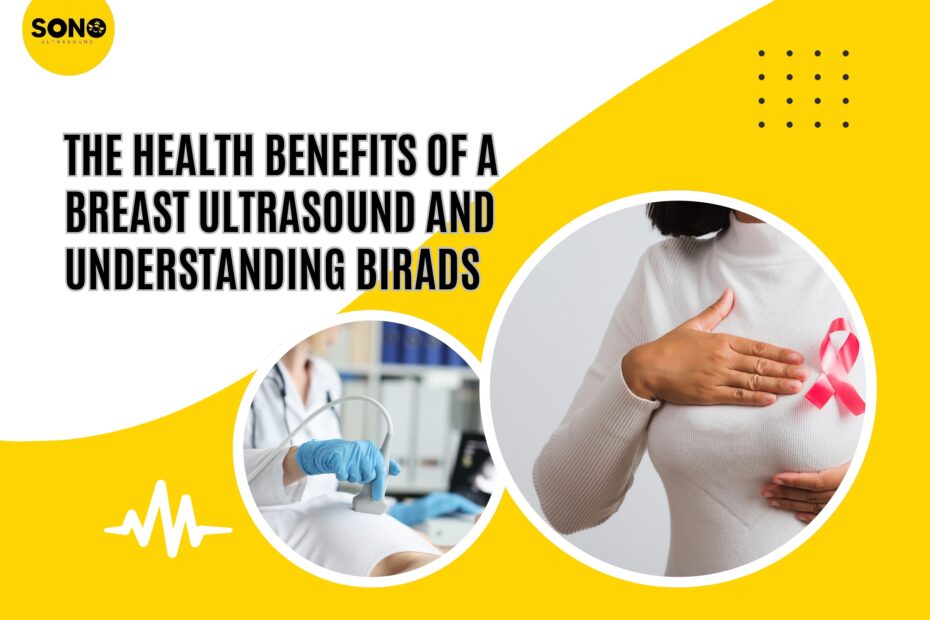A breast ultrasound is a safe, painless, and non-invasive test that uses sound waves to create images of the inside of the breast. It helps doctors see any abnormalities or lumps that may not show up on a regular physical exam or mammogram. Breast ultrasounds are often used to look more closely at areas of concern found on a mammogram or when a woman has dense breast tissue, which can make it harder to detect lumps. Along with the ultrasound, a system called BIRADS is used to classify findings and assess the likelihood of a condition being cancerous.
What is a Breast Ultrasound?
A breast ultrasound uses a small device called a transducer, which is gently moved over the skin of the breast. The transducer sends sound waves into the breast tissue, and these waves bounce back to form images on a screen. This test is non-invasive and does not use radiation, making it safe for women of all ages, including pregnant women.
A breast ultrasound can show whether a lump is solid (which might indicate a tumor) or fluid-filled (like a benign cyst). This information helps doctors decide if more testing is needed or if the lump is harmless.
Health Benefits of a Breast Ultrasound
There are several health benefits to performing a breast ultrasound, especially for women with certain risk factors or breast conditions:
- Seeing What Mammograms Might Miss
For women with dense breast tissue, mammograms might not show lumps clearly. Dense tissue appears white on a mammogram, just like some types of lumps, making it harder to distinguish between the two. An ultrasound can provide a clearer image in these cases, helping doctors spot abnormalities that may be hidden in dense tissue.
- Checking Lumps and Abnormalities
If a lump is found during a physical exam or a mammogram, a breast ultrasound can help determine if it is a solid mass (which could be cancerous) or a fluid-filled cyst (which is usually benign). This helps doctors make decisions about whether further testing, such as a biopsy, is necessary.
- Guiding Biopsies
If a suspicious area is found, an ultrasound can help guide a biopsy needle to the exact location to remove a small tissue sample. This makes the biopsy more accurate and ensures that the right area is being tested.
- Non-Invasive and Safe
Unlike X-rays or mammograms, an ultrasound does not use any radiation. It’s a completely safe option, especially for women who may need frequent monitoring due to a higher risk of breast cancer.
What is BIRADS?
BIRADS stands for Breast Imaging Reporting and Data System. It is a classification system that helps doctors describe and assess the findings from breast imaging tests like mammograms and ultrasounds. BIRADS uses a numerical scale from 0 to 6 to indicate the level of concern:
- BIRADS 0: More imaging needed.
- BIRADS 1: Normal, no issues.
- BIRADS 2: Benign (non-cancerous findings).
- BIRADS 3: Probably benign, but follow-up is needed.
- BIRADS 4: Suspicious, consider a biopsy.
- BIRADS 5: Highly suspicious, likely cancerous.
- BIRADS 6: Proven malignancy (already confirmed as cancer).
Health Benefits of Using BIRADS
- Clear Communication
BIRADS helps doctors communicate findings clearly, making it easier for patients to understand their results.
- Guided Treatment Decisions
The BIRADS score helps doctors decide on the next steps, whether that’s further imaging, a biopsy, or simply regular monitoring.
- Reducing Unnecessary Biopsies
BIRADS helps avoid unnecessary biopsies for lumps that are likely benign, offering peace of mind and minimizing anxiety for patients.
Sonobee recommend a breast ultrasound because it’s a valuable tool for detecting and evaluating lumps and other abnormalities in the breast. When combined with the BIRADS classification system, it helps doctors make accurate diagnoses and recommend the best course of action. This safe, non-invasive test provides peace of mind and ensures that any breast concerns are properly assessed and managed.
Book your Slot Here
Disclaimer: This content is for informational purposes only and should not replace professional medical advice. Please consult a doctor for any concerns
